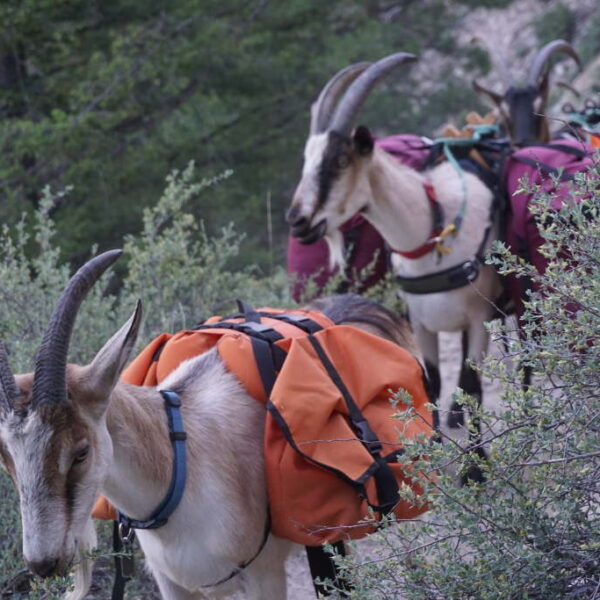My Store

Castrating Wethers: How Long Should You Wait
Banding Pack Goats
Castrating Wethers and when has been debated between the folks in the pack goat community forever. We are, as a community the most experienced at keeping wethers alive and well of any other goat niche. It seems to always get into hot debate and people are super passionate that they are "right," yet their advice varies widely. So let me tell you how I have arrived at my conclusion of when I band my little ones. First, let's speak about what both sides of the debate believe in, and why.
The 30 Days Crowd
Many knowledgeable people believe it's best to band your pack goat kid at 30 days. The main reasoning being size, temperament and optimal ease of the process itself. Believers in this side speak about it being the best strategy for growing big goats. Dealing with "puberty" and then, the soon to follow rut, is very stressful and will decrease their size. They speak specifically to shorter leg length. They also believe there is a higher risk of aggression toward other goats as well as you, if they have more life with testosterone in it. And lastly, they believe the stress of the banding process itself and its best success should be done when they are little.
The 6 Months Crowd
Others say around 6 months is the right time to band your pack goat. They feel this is the right choice for the following reasons. They believe pack goats will develop a stronger skeletal structure as well as become more muscled. They also vehemently believe it will help with urethra development (making it larger) and less likely to foster Urinary Calculi. The "opposed" to this theory say that the increase in size is so little, it's not worth the overall "risk" of leaving them for that long.
My Conclusion
So, here is where I stand on the issue. I feel that the opposing sides to this argument both have very valid stands and I agree with much of both positions. So, I shoot to error on the side of caution and I band between 4 and 6 months. I’d say there is no hard science to any of this yet with growing wethers long term. The closest we have are the meat folks but they only keep them alive for 1 year. But remember they band at 30 days and is their recommendation and they are trying for size. If there is hard science about height and long term growth, I couldn’t find it. (And we looked hard)
There are a few main reasons why I land between 4 and 6 months to castrate a wether. 4 to 6 months allows for easier banding than later. This is a less stressful event and will "put them back" less in that critical first year where they get near 50-60% of their total growth over their 4 year growth cycle. As well, I have raised many packers intact, many times. I do this only because I breed them, then castrate at 6 months with the California Bander. Surgical castration and using the burdizzo tool are other options but both are way more impactful than banding young. I would never do this if it weren’t for breeding. They lose ground as they recover from castration in that most important first year whenever you castrate them no matter how. Recent research into urinary calculi has changed my methodology a bit. Leaving the goat intact up to 4 or 6 months does allow the urethra to grow to its largest size. This is helpful in passing stones. We have found that a proper Calcium:Phosphorus ratio in the diet and water source can help reduce the chances of stone development. We encourage testing of both feed and water.
The other main factor is they definitely go through a personality change at 3-4 months that carries risk of many things that don’t bode well for a gentle packer or wether (which is what you want). Also, big horns are a pain. The bigger... the more of a pain. Especially if they have any kind of flair. And their horns grow super-fast when they have their junk. So, for those predominant reasons... 4 to 6 months is what I recommend.
We are likely splitting hairs on growth. I think we are also splitting hairs on UC (it kills a lot of goats but it’s way more about diet). All the deaths I have seen and opened up after (over 10 now people have sent me pictures of) are not one or two little stones that barely didn’t make it through. They have hundreds of them, all packed in there, and no size of urethra could have passed them. I personally think the three largest downsides to keeping them intact is horn size, stress of late castration and the risk of changing temperaments. Temperament is the biggy... Past 4 to 6 is a mistake for this fact alone. That is when they will start peeing on themselves. When that starts happening you will interact with them less and they become a “pain” to deal with. This may likely make you “shorter” with them as well. Both are risky actions to take with a packer.
I think anything beyond 4 to 6months has a risk/reward ratio that is out of skew. That’s what I base my decision on is the overall impact on all components as I see them. Once again, I will tell you some of this is fact and some of it has no scientific evidence to back it up at all. Gathering all this info is what my opinion is based on and what I do when I’m not breeding my bucks. For a good diet to help your goat reduce his chances of dealing with UC, follow this feeding system.
2022 Updated Nutrition Guide: https://packgoats.com/product/comprehensive-goat-nutrition-guide/
I hope that helps. Marc





